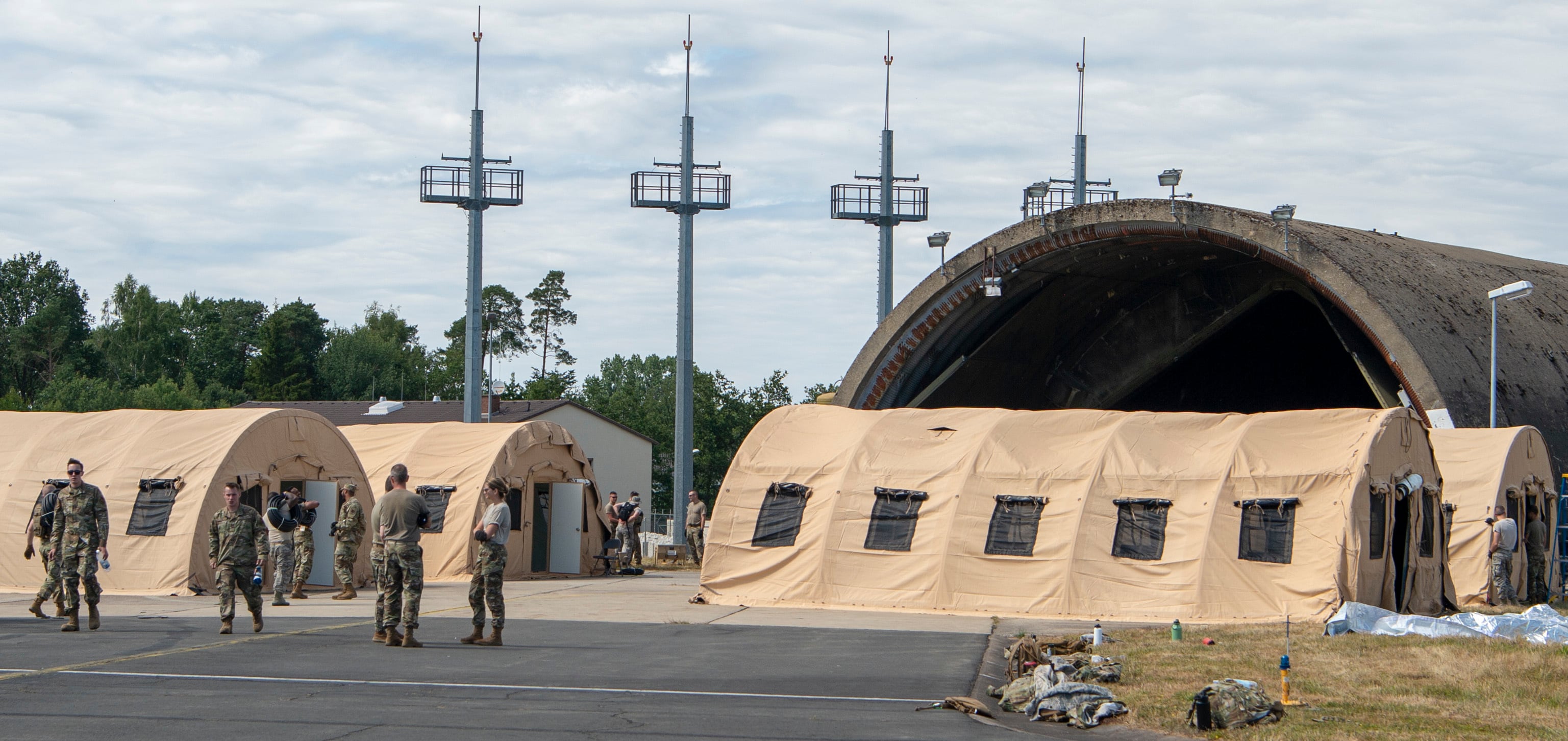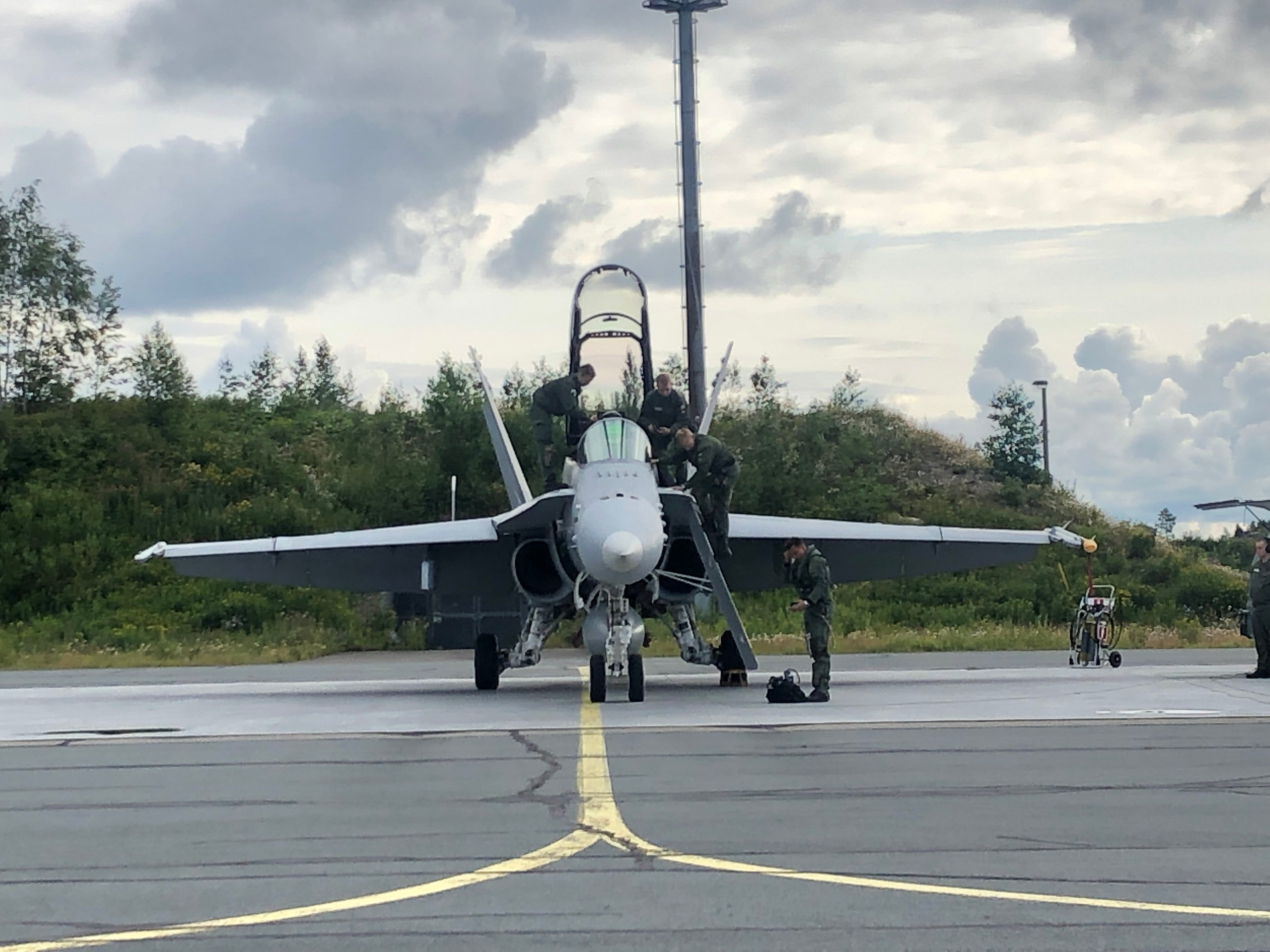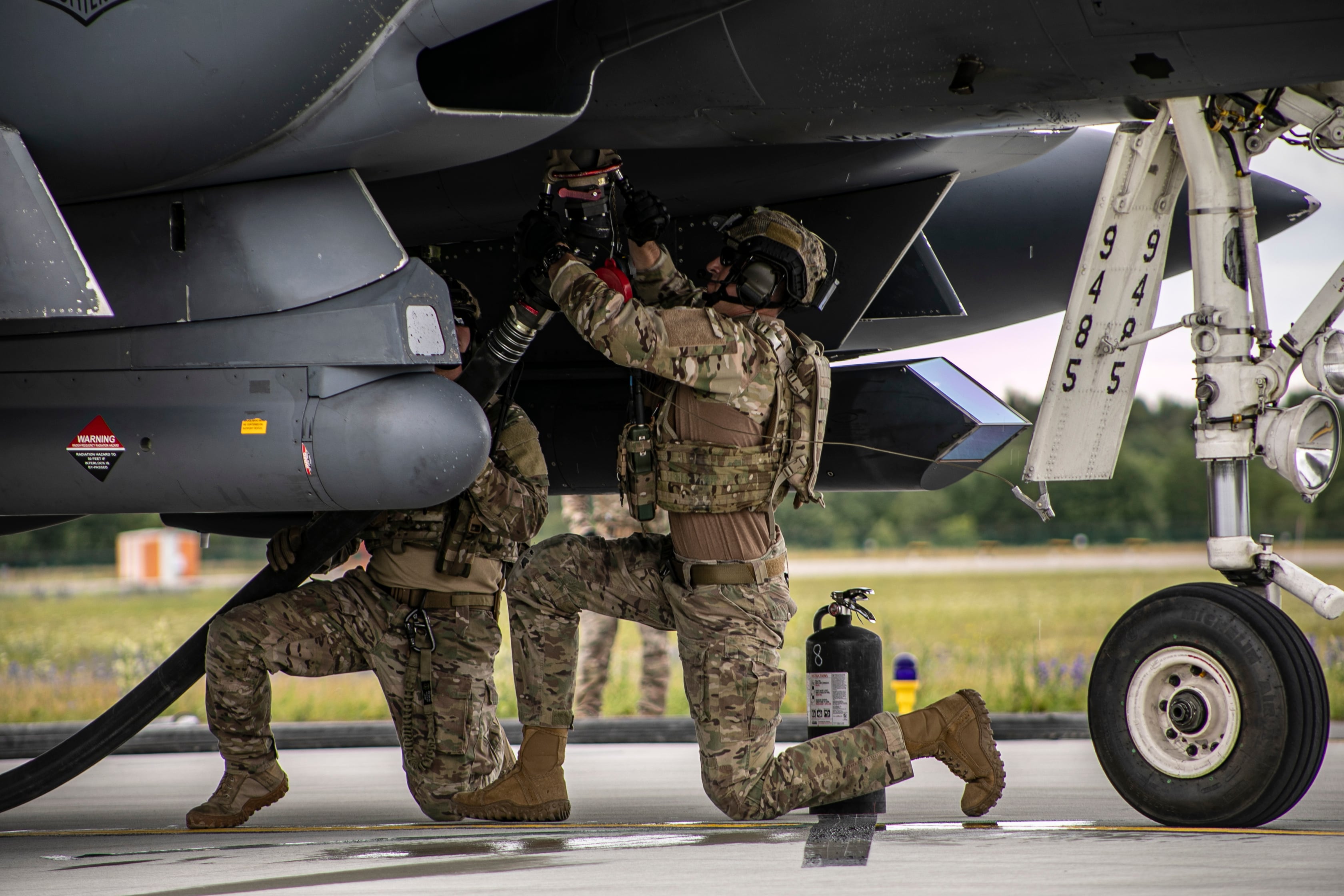SPANGDAHLEM AIR BASE, Germany — A U.S. Air Force F-15E Strike Eagle prepares to touch down at Poland’s Powidz Air Base when a bird strike takes out one of the fighter’s two engines, forcing an emergency landing. Meanwhile, on Powdiz’s ramp, another F-15E pilot sees a warning light turn on, halting plans to take off until further notice.
Both jets were supposed to be on the ground in Poland for a short amount of time — enough to get refueled or rearmed with inert weapons before taking off again. A broken jet is a real problem for the U.S. Air Force personnel temporarily stationed at Powdiz, and they response by immediately going into crisis mode.
It’s a perfect test for Operation Rapid Forge, a U.S. Air Force exercise held in Europe this July that was meant to test the service’s ability to rapidly deploy to partner nation bases — and in some cases, to live in the spartan conditions airmen could face in a battle with a near-peer adversary like Russia or China.
The exercise involved F-35s from the 88th and 419th fighter wings at Hill Air Force Base, Utah; F-15E Strike Eagles from the 4th Fighter Wing at Seymour Johnson Air Force Base, North Carolina.; MC-130J planes from the 352nd Special Operations Wing at RAF Mildenhall, England; and C-130J cargo aircraft from the 86th Airlift Wing at Ramstein Air Base, Germany, and from the 317th Airlift Wing from Dyess Air Force Base, Texas.
Over a two-week period, those aircraft trained over Europe and made brief stops at Powidz, as well as Lielvarde Air Base in Latvia, Siauliai Air Base in Lithuania, and Ämari Air Base in Estonia, for refueling and rearming by U.S. Air Force personnel under strict time constraints.
"This is kind of expeditionary — getting people to learn and understand how to be in the field,” said Col. Donn Yates, the commander of the 4th Fighter Wing, which led and organized Operation Rapid Forge. “These are things that the mainstream U.S. Air Force have not done in a long time.”
Members of the 4th Fighter Wing deployed to Spangdahlem Air Base, Germany, lived and worked out of tents used for mission planning, communications, readying life-support gear and other functions.
Additionally, some personnel were trained as “multifunctional airmen” to take on multiple jobs while on the ground in Poland, Estonia and Latvia, such as driving refueling trucks, pumping JP-8 fuel into jets on the ramp and providing base security, among more specialized tasks like loading weapons or performing maintenance.
All were cut off from running water, hot meals and indoor toilets.

“The more it sucks out here — and you’re eating MREs [Meals Ready-to-Eat] and you’re pooping out in the Porta-John — the higher the morale is,” Yates said. “We had people out in Poland sleeping in hammocks and stuff, not because we had to but because I wanted them to feel what it is like to live in the field. And from that they feel like they’re really, really making progress to defend the nation.”
In the event of war
Under the latest National Defense Strategy, the Air Force is questioning the resiliency of its established bases and putting thought into how the service could establish a makeshift airfield or use partner nations’ bases to distribute assets should war break out.
“It is about combat-credible forward forces; that is, forces that are or can rapidly get forward, survive a withering Chinese or Russian assault, and blunt the adversary’s aggression,” Elbridge Colby, who co-led development of the National Defense Strategy, wrote in January 2019 testimony to Congress. “And it is about bases, operating locations and logistic networks that can perform their missions in support of these goals, even under heavy and sustained enemy attacks.”
Simply put, the Air Force can’t count on its installations to withstand the type of prolonged attacks that Russia and China could mount, and the service must be able to swiftly regenerate air power from alternate sites should its primary bases became unusable.
That problem was on the mind of Air Force Chief of Staff Gen. Dave Goldfein during a July trip to Finland.
RELATED

The Finnish Air Force disperses its aircraft among four bases inside the country, but all its aircraft can operate from Finland’s many “road bases”— basically a highway strip that is equipped to function as a runway. The service trains its personnel to secure and stand up road bases, and it regularly demonstrates its ability to operate from the bases during exercises.
The U.S. Air Force could learn from that, Goldfein told Defense News after the visit.
"While we do have a lot of bases, I don’t know which of those are going to be available for the time I need it,” he said.
“So I’ve got to be more agile than that, and it might be that I’m setting up a base that doesn’t actually exist. I have a long enough track of concrete, some source of water, and that’s all I’ve got, and now I have to rapidly stand it up and do all those key tasks,” he added. “Stand up a base, defend the base, receive forces, be able to connect into the command and control, and then be able to operate in a contested environment. They’re already thinking about that."
One means of doing this involves pre-positioning equipment in Europe, as well as making key investments to partner nations’ bases to fund things like runway repairs and new hangars. Last year, the U.S. Air Force conducted a proof of concept for “deployable air bases,” demonstrating that airmen could transfer shipping containers full of equipment to Poland’s 31st Air Base in Krzesiny and set up a camp and airfield infrastructure needed to launch planes.
In fiscal 2020, the Air Force plans to spend $278 million to pre-position additional equipment throughout Europe and $241 million on construction efforts to support expeditionary basing.

Solving the F-15E problem
The first step to fixing the two broken F-15Es on the flight line at Powdiz was getting the air operations center to furnish the diplomatic clearances that would allow the U.S. Air Force to keep aircraft on the ground and to coordinate the transfer of repair parts into Poland.
Maintainers initially requested two C-130s filled with 15 pallets of equipment. The request was denied.
“They wanted the world," Yates said. "And they’re like: ‘Negative. You’re getting one [C-130].’ ”
After some creative thinking, the maintainers were able to whittle down their request to seven and a half pallets, or enough to fit on a single C-130.
Once the equipment was flown in — another task that required coordination to ensure aircrew wouldn’t be removed from other responsibilities — the maintainers conducted a full engine swap in the field while simultaneously fixing the other F-15.
Yates declined to say how long it took to get the necessary equipment to Powdiz.
"They were able to respond relatively quick. Could we have responded quicker? Absolutely,” he said. "Everyone is patting themselves on the back and going: ‘Hey, this is what we’re built to do.’ But this is a real microcosm.”
For the F-35 pilots participating in the exercise — who did not live in austere conditions — the biggest challenges were sticking to a strict schedule and coordinating with both the 4th Fighter Wing and the foreign bases involved in the effort, said Lt. Col. Max Cover, an F-35A pilot with the 421st Fighter Squadron.
"Going into Lithuania, I’m talking to someone in the tower, so we have a language barrier showing up from the get-go,” he said. “Our taxiways are limited in terms of width and space and where you can set up [fuel] trucks. You have to have the required security perimeters for the aircraft, you have to have the required distances for intakes, exhaust, for the fuel itself.
“If you look at the way Siauliai Air Base is laid out, our options were very limited in how we did this. We had to execute on a single taxiway with a small concrete pad, and so we had to do it time-based, deconflicted with the Strike Eagles because if they showed up at the same time, it would have been congested and we wouldn’t have been able to do it."
Although Rapid Forge presented an opportunity for F-15E and F-35A pilots to clock in valuable flight hours as they trained over Europe, Yates said the exercise was more important in terms of stressing the Air Force’s logistics enterprise and forcing young airmen to creatively solve problems — even if that meant working outside of the usual processes.
“Speed and tempo are going to be really important for us in whatever we do, whether its messaging, whether its operations, whether its basing, logistics and supply,” he said.
"As you’re brought up as a young flier — my background is F-15E — you just think about dropping the bombs and shooting the missiles or whatever, but you don’t think about the whole machine that puts you out there, " he added. "But if you’ve been out there and you’ve seen these things, you know that the key to all operations is logistics.”
Valerie Insinna is Defense News' air warfare reporter. She previously worked the Navy/congressional beats for Defense Daily, which followed almost three years as a staff writer for National Defense Magazine. Prior to that, she worked as an editorial assistant for the Tokyo Shimbun’s Washington bureau.





